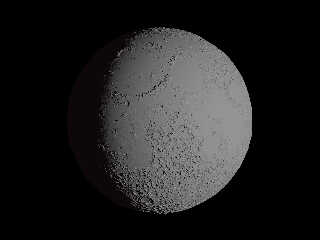|
 |
I have written a small (?) tutorial on how to create a planet with
high-resolution maps, image-maps, bump-maps and spherical heightfields.
https://www.maetes.com/en/blog/how-to-build-a-planet
Since there may be more tutorials at some point, I would of course be interested
in your opinion. It's useless if no one understands it or wants to read it.
Too short, too long, too much text, too many details, incomprehensible, errors
inside, whatever.
I guess I've told too much. Unfortunately, I kept coming up with more and more
text.
Greeting Martin
Post a reply to this message
Attachments:
Download 'povray_tutorial_planet_step3_moon.jpg' (208 KB)
Preview of image 'povray_tutorial_planet_step3_moon.jpg'

|
 |
|
 |
On 06/11/2025 22:16, Maetes wrote:
> Since there may be more tutorials at some point, I would of course be interested
> in your opinion. It's useless if no one understands it or wants to read it.
Thanks for this tutorial, I like the detailed explanations and
step-by-step approach.
Maybe I will use it in my VR-Planetarium project, this is the first
draft (POC):
https://yesbird.online/gallery/?m=deep_space&e=env_space2&r=true
--
YB
Post a reply to this message
|
 |
|
 |
"Maetes" <nomail@nomail> wrote:
> I have written a small (?) tutorial on how to create a planet with
> high-resolution maps, image-maps, bump-maps and spherical heightfields.
>
> https://www.maetes.com/en/blog/how-to-build-a-planet
>
>
> Since there may be more tutorials at some point, I would of course be interested
> in your opinion. It's useless if no one understands it or wants to read it.
>
> Too short, too long, too much text, too many details, incomprehensible, errors
> inside, whatever.
>
> I guess I've told too much. Unfortunately, I kept coming up with more and more
> text.
>
> Greeting Martin
Fine work! I have used everything you had in part 1! It was easy to follow, well
written, and plenty of graphics. It had all that was needed and not much you
didn't.
Part2 is not as well organize. From the line:
You can continue experimenting with the variables or parameters Radius,
HeightDiff, max_gradient and accuracy.
Where it didn't mention that this was for an isosurface, to the 'PRO's & CON's
that leave image_maps and isosurfaces off the list.
I did like the animation and I always like Mars. A few years back I drove
deeply into Mar with POV with image and bump maps. Exploring Mars by adding
water levels and cutting the tops off the high ground. But I'm getting off
topic.
Part2 doesn't feel like a tutorial, but more like 'look at this stuff'.
I appreciated the work you did putting this altogether. I remember the hours I
spent working with Mars and other planets.
Have Fun!
Post a reply to this message
|
 |




![]()